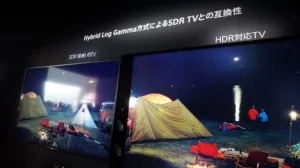The International Telecommunication Union (ITU) has developed and published a new HDR standard (aka Recommendation) for television broadcasting. The standard was developed by the ITU’s Radiocommunication sector (ITU-R), working with industry stakeholders. It builds on the ITU’s UHDTV Recommendation BT.2020, which was approved in October 2015.
Sony is one of the companies that has demonstrated Hybrid Log Gamma in the past. Image: UbergizmoOfficially known as ITU-R HDR-TV Recommendation BT.2100, the standard enables programmes to take advantage of HDR technology, using two options: Perceptual Quantization (PQ) and Hybrid Log-Gamma (HLG).
The PQ specification achieves a range of brightness levels using a transfer function, which is tuned to match the human visual system. HLG, on the other hand, more closely matches previously-established TV transfer curves and so is more compatible with legacy displays. The Recommendations also outlines a conversion process between the two options.
TV producers using the BT.2100 Recommendation can choose between 1920 x 1080, UltraHD (3840 x 2160) and 8k (7680 x 4320) resolutions. All use the progressive imaging system with extended colour gamut and a range of frame rates, specified in Recommendation BT.2020.
Like the UltraHD Premium specification, the ITU’s Recommendation defines a peak luminance of at least 1,000 cd/m² (for small highlights, although those highlight areas are not defined), with a black level luminance of 0.005 cd/m² maximum for ‘critical viewing’. Other defined image parameter values can be found at http://tinyurl.com/gu9862c.
Analyst Comment
Much of the BT.2100 standard reflects decisions in BT.2020. We noted that the standard allows the use of HDR for 1080P content, which will be a popular format for broadcasters, we think. The standard also makes no reference to metadata, so the static PQ curve, rather than a dynamic version, has been adopted and gives some information on converting between PQ and HLG. As we have been reporting for some time (BBC Approach to HDR Has Advantages for Broadcasters and onwards), one of the concerns that broadcasters had about metadata is that it could get corrupted, or lost, especially in live broadcasting.
As you would expect, the colorimetry of BT.2100 is based on Rec. 2020.
The ITU is the most influential body for broadcast, so we would expect regional organisations such as the EBU to adopt the ITU standard. (BR)
Note: the last paragraph of this article was amended to clarify the minimum/maximum levels.

